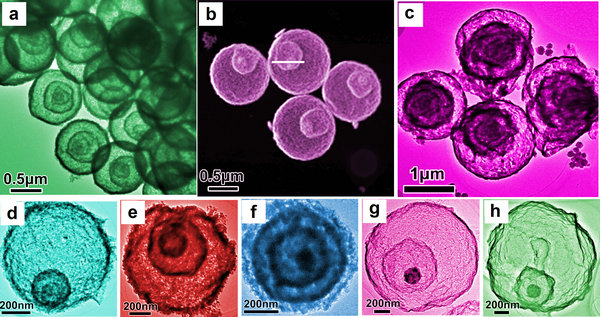Hollow spheres with nanometer-to-micrometer dimension, controlled interior structure, and defined shell composition are widely applicable in catalysis, drug delivery, energy conversion and storage systems, chemical sensors, biotechnology, etc. In order to meet the needs of the rapid development of those possible applications, more recent research effort has been made at designing and synthesizing hollow spheres with higher-level interior structure (such as multi-shelled hollow structure), which is expected to provide more advantages in drug release with prolonged release time, heterogeneous catalysis, and Li-ion batteries etc. However, the existing synthetic methods are suitable for common single-shelled hollow sphere or only particular materials. It remains a challenge to seek a general synthetic approach for making multi-shelled hollow nanostructures of any desired material.
Recently, IPE Professor Wang Dan and his group havedeveloped a sequential templating strategy for fabrication of multiple-shell metal oxide hollow microspheres (Figure 1). By using carbonaceous microsphere as template, rationally controlling the adsorption of metal ions on templates, and temperature-programmed heating of the composite microsphere to adjust the rates of forming metal oxide shell and combusting templates, a series of multiple-shell hollow microspheres such as α-Fe2O3, Co3O4, NiO, CuO, ZnO, and ZnFe2O4, with single, binary metal oxides, even heterogeneous shell compositions have been achieved (Figure 2). Experimental data show these architectures can exhibit much better performance than those of their counterparts with single shells when served as gas sensor materials or photoanodes of dye-sensitized solar cells.
The strategy used herein could be expected to prepare other multiple-shell hollow structures with different shapes, sizes, and compositions by choosing appropriate template and precursor material. The research may open up new opportunities for preparing advanced materials based on various complex multiple-shell hollow structures for multipurpose applications. This work has been recently published in Angewandte Chemie International Edition.
This work was supported by the National Natural Science Foundation of China (No. 20971125, 21031005, and 21006116), Beijing Municipal Natural Science Foundation (No. 2082022), and the Foundation for State Key Laboratory of Multi-phase Complex Systems.

Figure 1. Illustration of the sequential templating approach to multiple-shell hollow metal oxide microsphere.

Figure 2 a)TEM image of quadruple-shell NiO hollow microspheres; b) STEM image of triple-shell NiO hollow microspheres; TEM images of other multiple-shell hollow microsphere of c) α-F2O3, d) Co3O4, e) CuO, f) ZnO, g) ZnFe2O4 and h) ZnO@ZnO/ZnFe2O4@ZnO/ZnFe2O4.